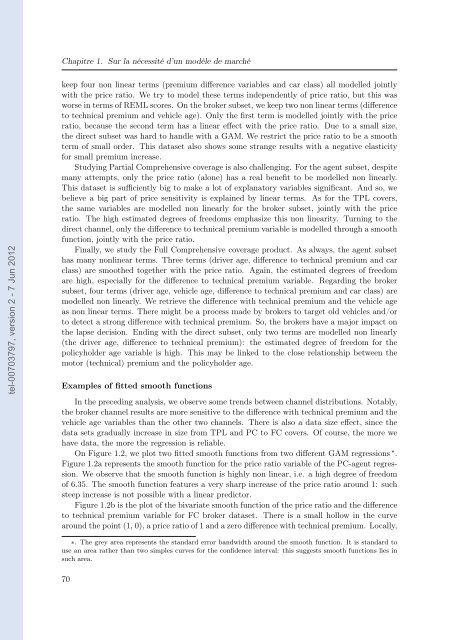Etude des marchés d'assurance non-vie à l'aide d'équilibres de ...
Etude des marchés d'assurance non-vie à l'aide d'équilibres de ...
Etude des marchés d'assurance non-vie à l'aide d'équilibres de ...
Create successful ePaper yourself
Turn your PDF publications into a flip-book with our unique Google optimized e-Paper software.
tel-00703797, version 2 - 7 Jun 2012<br />
Chapitre 1. Sur la nécessité d’un modèle <strong>de</strong> marché<br />
keep four <strong>non</strong> linear terms (premium difference variables and car class) all mo<strong>de</strong>lled jointly<br />
with the price ratio. We try to mo<strong>de</strong>l these terms in<strong>de</strong>pen<strong>de</strong>ntly of price ratio, but this was<br />
worse in terms of REML scores. On the broker subset, we keep two <strong>non</strong> linear terms (difference<br />
to technical premium and vehicle age). Only the first term is mo<strong>de</strong>lled jointly with the price<br />
ratio, because the second term has a linear effect with the price ratio. Due to a small size,<br />
the direct subset was hard to handle with a GAM. We restrict the price ratio to be a smooth<br />
term of small or<strong>de</strong>r. This dataset also shows some strange results with a negative elasticity<br />
for small premium increase.<br />
Studying Partial Comprehensive coverage is also challenging. For the agent subset, <strong><strong>de</strong>s</strong>pite<br />
many attempts, only the price ratio (alone) has a real benefit to be mo<strong>de</strong>lled <strong>non</strong> linearly.<br />
This dataset is sufficiently big to make a lot of explanatory variables significant. And so, we<br />
believe a big part of price sensitivity is explained by linear terms. As for the TPL covers,<br />
the same variables are mo<strong>de</strong>lled <strong>non</strong> linearly for the broker subset, jointly with the price<br />
ratio. The high estimated <strong>de</strong>grees of freedoms emphasize this <strong>non</strong> linearity. Turning to the<br />
direct channel, only the difference to technical premium variable is mo<strong>de</strong>lled through a smooth<br />
function, jointly with the price ratio.<br />
Finally, we study the Full Comprehensive coverage product. As always, the agent subset<br />
has many <strong>non</strong>linear terms. Three terms (driver age, difference to technical premium and car<br />
class) are smoothed together with the price ratio. Again, the estimated <strong>de</strong>grees of freedom<br />
are high, especially for the difference to technical premium variable. Regarding the broker<br />
subset, four terms (driver age, vehicle age, difference to technical premium and car class) are<br />
mo<strong>de</strong>lled <strong>non</strong> linearly. We retrieve the difference with technical premium and the vehicle age<br />
as <strong>non</strong> linear terms. There might be a process ma<strong>de</strong> by brokers to target old vehicles and/or<br />
to <strong>de</strong>tect a strong difference with technical premium. So, the brokers have a major impact on<br />
the lapse <strong>de</strong>cision. Ending with the direct subset, only two terms are mo<strong>de</strong>lled <strong>non</strong> linearly<br />
(the driver age, difference to technical premium): the estimated <strong>de</strong>gree of freedom for the<br />
policyhol<strong>de</strong>r age variable is high. This may be linked to the close relationship between the<br />
motor (technical) premium and the policyhol<strong>de</strong>r age.<br />
Examples of fitted smooth functions<br />
In the preceding analysis, we observe some trends between channel distributions. Notably,<br />
the broker channel results are more sensitive to the difference with technical premium and the<br />
vehicle age variables than the other two channels. There is also a data size effect, since the<br />
data sets gradually increase in size from TPL and PC to FC covers. Of course, the more we<br />
have data, the more the regression is reliable.<br />
On Figure 1.2, we plot two fitted smooth functions from two different GAM regressions ∗ .<br />
Figure 1.2a represents the smooth function for the price ratio variable of the PC-agent regression.<br />
We observe that the smooth function is highly <strong>non</strong> linear, i.e. a high <strong>de</strong>gree of freedom<br />
of 6.35. The smooth function features a very sharp increase of the price ratio around 1: such<br />
steep increase is not possible with a linear predictor.<br />
Figure 1.2b is the plot of the bivariate smooth function of the price ratio and the difference<br />
to technical premium variable for FC broker dataset. There is a small hollow in the curve<br />
around the point (1, 0), a price ratio of 1 and a zero difference with technical premium. Locally,<br />
∗. The grey area represents the standard error bandwidth around the smooth function. It is standard to<br />
use an area rather than two simples curves for the confi<strong>de</strong>nce interval: this suggests smooth functions lies in<br />
such area.<br />
70
















